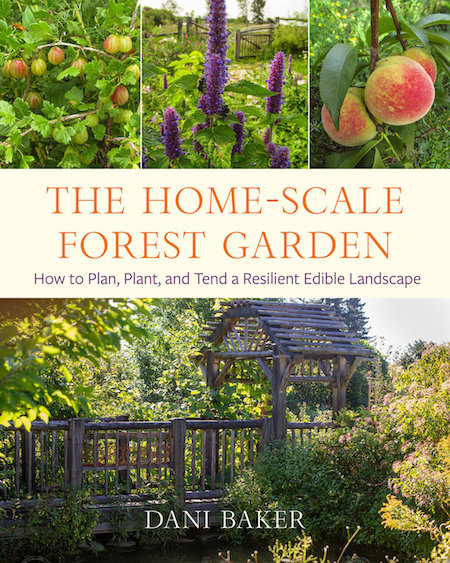
by Dani Baker
Chelsea Green Publishing, 2022
336 pages, paperback, $34.95
Somehow, I naively thought that forest gardening involved growing crops in the forest. While people do harvest nuts, fruits and herbs from the woods, “forest gardening” has come to mean gardening “like a forest.” In “The Home-Scale Forest Garden,” Dani Baker shows how to design a multi-layered garden of edible plants that mimics the ecology of a forest. These gardens produce food, help build soil and provide habitat for a diversity of species. Even so, you’ll want to keep the vegetable patch going for your sun-loving tomatoes.
Establishing a forest garden takes labor and materials, such as initial inputs of compost and mulch. But once established, the gardens are self-sustaining and don’t require as much work. Without the need for daily maintenance, a forest garden can be situated further from the house as part of a landscape feature.
What I like about this book is that Baker comes to forest gardening with a sense of adventure. Creating a forest garden is a cross between landscaping and experimenting, and you don’t need tons of space. Baker’s first forest garden began as a 100-by-200-foot strip of land, but you can make them smaller. To demonstrate, she shows how a 25-square-foot forest garden can include an overstory layer (honey locust), an understory (fruit tree), shrubs (berries), and flowers. Daylilies provide the edible root layer.
Let nature do the work, Baker counsels. By maximizing the diversity of plants, and the different layers, a gardener provides more habitats for beneficial insects (and birds). Those beneficials help protect against pests and disease. Not only do the shrub and tree layers offer vertical productivity, their fallen leaves nourish the soil.
Baker strongly advises that gardeners spend time observing the land: Draw a map and note the slopes, spots where rain pools, where wind tends to blow, where the temperature drops. She shows how to make raised beds and mounds, add swales and ponds, and offers advice on how to exclude deer.
A good 50% of the book describes plants for each layer of the forest garden. Nut trees make good choices for overstory (though mulberry fits in well, too) while fruit trees fit in well as the understory. If you already have some fruit trees, flowering crabapple or redbud trees, perhaps you could create an edible forest garden around them.
The next layer is shrubs, and Baker provides a long list of choices including blackberries, raspberries, currants, elderberries … but not blueberries. They require acidic soil which may not mesh with the goals of the garden as a whole. The herbaceous layer grows from 1 to 10 feet, and includes such plants as asparagus, chamomile, chives, coneflowers, daylilies, sunflowers and more.
She provides suggestions for ground covers (strawberries!) and vines and fungi (grapes, hops and oyster mushrooms). For each plant she notes its native range and soil conditions as well as cultural information. Throughout the book Baker sprinkles her own tales of unexpected discoveries and lessons learned: floating row cover may keep the birds off your berries, but it is not a good substitute for bird netting. At the end she provides a table of flowering and harvest times for all the plants in the book, based on her zone 4 experience.
Sue Smith-Heavenrich, Candor, New York
